Digital Posters
Flow, Diffusion & Preclinical Modelling in Stroke Imaging
ISMRM & SMRT Annual Meeting • 15-20 May 2021

| Concurrent 6 | 19:00 - 20:00 |
4342.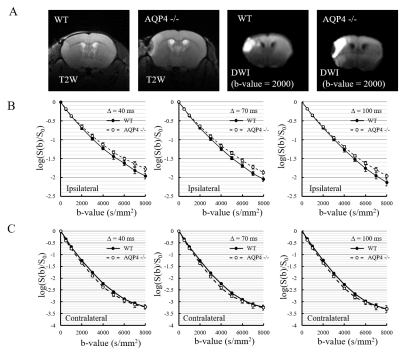 |
Exploring the effect of aquaporin-4 suppression on cell membrane water exchange in a mouse model of brain ischemia using diffusion-weighted MRI
Takuya Urushihata1, Hiroyuki Takuwa1, Manami Takahashi1, Yasuhiko Tachibana2, Jeff Kershaw2, Nobuhiro Nitta2, Sayaka Shibata2, Masato Yasui3, Makoto Higuchi1, and Takayuki Obata2
1Department of Functional Brain Imaging Research, National Institute of Radiological Sciences, QST, Chiba, Japan, 2Applied MRI Research, National Institute of Radiological Sciences, QST, Chiba, Japan, 3Keio Advanced Research Center for Water Biology and Medicine, Keio University, Tokyo, Japan
We measured multi-b-value multi-diffusion-time (MbMTd) DWI and compared ADCs in the ischemic focii of aquaporin4-knockout (AQP4-KO) and wild type (WT) mice. In the ischemic region, AQP4-KO mice showed lower ADCs compared to WT mice, whereas higher ADCs were observed in the contralateral region. In addition, we compared estimates of cell membrane water exchange time obtained by fitting a two-compartment exchange model to the DWI signal. The exchange-time was approximately 2.5 times longer for the AQP4-KO mice than for the WT mice. These results suggest that MbMTd DWI may be useful for in vivo research and clinical diagnosis of AQP4-related diseases.
|
|||
4343.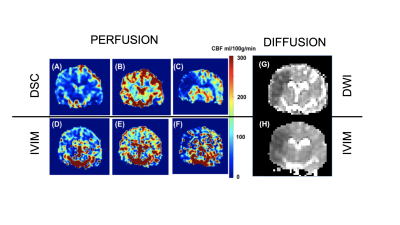 |
Accuracy of Intravoxel Incoherent Motion (IVIM) for quantification of perfusion-diffusion mismatch in Acute Stroke.
Mira Liu1, Yong Jeong1, Gregory Christoforidis1, Niloufar Saadat2, Steven Roth3, Marek Niekrasz1, and Timothy Carroll1
1The University of Chicago, Chicago, IL, United States, 2Northwestern University, Chicago, IL, United States, 3University of Illinois at Chicago, Chicago, IL, United States
This is a retrospective validation study of intravoxel incoherent motion (IVIM) over a range of physiologic conditions: normocapnia, hypercapnia, and post middle cerebral artery occlusion. We performed controlled two-day experiments in a canine model (n=17) of ischemic stroke with baseline (normocapnia) and hypercapnia on the first day followed by occlusion on the second. We compared IVIM perfusion and diffusion images with neutron capture microsphere perfusion, DSC perfusion, and Apparent Diffusion Coefficient (ADC) from standard DWI. We found excellent agreement between IVIM for both perfusion and diffusion indicating IVIM may serve as a means of stratifying acute stroke patients for treatment.
|
|||
4344.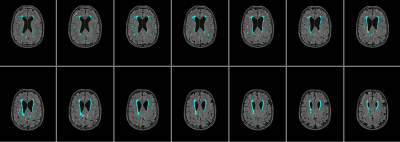 |
Central pulse pressure and its influence on carotid artery morphology predict white matter hyperintensity volumes
Andrew Crofts1, Jessica J Steventon2, Joseph R Whittaker3, Marcello Venzi1, Hannah L Chandler4, Mahfoudha Al Shezawi5, Eric J Stohr6, Chris Pugh6, Barry McDonnell6, and Kevin Murphy1
1Cardiff University Brain Research Imaging Centre (CUBRIC), School of Physics and Astronomy, Cardiff University, Cardiff, United Kingdom, 2CUBRIC, School of Medicine, Cardiff University, Cardiff, United Kingdom, 3Max Planck Institute for Human Cognitive and Brain Sciences, Leipzig, Germany, 4CUBRIC, School of Psychology, Cardiff University, Cardiff, United Kingdom, 5Cardiff Metropolitan University, Cardiff, United Arab Emirates, 6Cardiff Metropolitan University, Cardiff, United Kingdom
Cardiovascular risk factors have been linked with deteriorations in cerebrovascular function in the brain, causing cell loss, particularly in the white matter. The mechanisms by which cardiovascular risk factors influence the microvasculature is unclear. Increased blood pressure and associated arterial stiffness/morphological changes in larger cerebral vessels are thought to play a key role. Here, we demonstrate that central pulse pressure along with associated changes in carotid radius and tortuosity better predict the white matter lesion burden in the brain compared with other measures of blood pressure and systemic arterial stiffness.
|
|||
4345.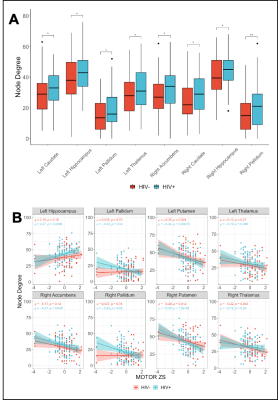 |
Changes in Functional Connectivity and Cognition in HIV Infected Individuals with Cerebral Small Vessel Disease
Kyle Douglass Murray1, Alan Finkelstein1, Miriam Weber1, Jianhui Zhong1, and Giovanni Schifitto1
1University of Rochester, Rochester, NY, United States
HIV-infected individuals are at increased risk of developing cerebrovascular diseases, such as cerebral small vessel disease (CSVD). Further, cognitive deficits as a result of chronic infection are common. In this abstract, we use a graph theoretical analysis of resting-state functional connectivity to show that functional and cognitive changes are driven by both HIV-infection and CSVD. We observed correlations between global and local graph theory metrics and cognitive scores derived from neuropsychological testing in the presence of HIV. We also describe potential compensatory changes in global brain function to combat functional deficits from HIV and CSVD.
|
|||
4346.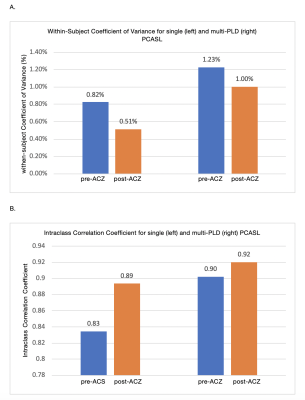 |
Is Arterial Spin Labeling Effective in Measuring Cerebrovascular Reactivity? A Test-retest Study on Impact of Labeling Efficiency
Taghi Rostami1, Moss Y Zhao2, Audry P Fan3, David Yen-Ting Chen4, Magdalina J Sokolska5, Jia Guo6, Yosuke Ishii7, David D Shin8, Mohamad Mehdi Khalighi2, Dawn Holley2, Kim Halbert2, Andrea Otte2, Brittney Williams2, Jun-Hyung
Park2, Bin Shen2, and Greg Zaharchuk2
1Bioengineering, Stanford University, Stanford, CA, United States, 2Radiology, Stanford University, Stanford, CA, United States, 3Medical Imaging, UC Davis, Davis, CA, United States, 4Taipei Medical University, Taipei, Taiwan, 5University College London Hospitals, London, United Kingdom, 6University of California Riverside, Riverside, CA, United States, 7Tokyo Medical. and Dental University, Tokyo, Japan, 8GE Healthcare, Menlo Park, CA, United States
In this study, we examined repeatability of labeling efficiency of single- and multi-PLD arterial spin labeling (ASL) MRI before and after vasodilation in 15 normal subjects. Individual measurements of hematocrit and flow velocity in the carotid and vertebral arteries, obtained by phase-contrast (PC) MRI, were used to assess the labeling efficiency for both ASL methods. Our results showed that both labeling techniques achieved high repeatability before and after vasodilation (within-subject Coefficient of Variance pre-ACZ: 0.82 and 1.23%, and post-ACZ: 0.51 % and 1.00%).
|
|||
4347.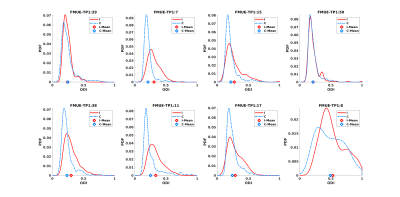 |
Using diffusion microstructure distributions for prediction of motor outcomes in stroke recovery
Anuja Sharma1, Clint Frandsen1, Ganesh Adluru1, and Edward DiBella1
1UCAIR, Dept. of Radiology and Imaging Sciences, University of Utah, Salt Lake City, UT, United States
We investigate the potential advantages of using distribution-valued variables to capture image information instead of the conventional techniques which use mean values to represent entire regions-of-interest. Using distribution-based distances in comparison with a mean-based approach, we explore various models to predict motor performance recovery in stroke patients. Our experiments indicate that for predictor variables Orientation Dispersion index and the Restricted Diffusion Index (diffusion scalars derived from the NODDI model), the distribution representations can lead to significantly improved regression models, over the respective mean values. Additionally, using the baseline Fugl-Meyer scores to predict follow-up Fugl-Meyer scores further enhances the model statistics.
|
|||
4348.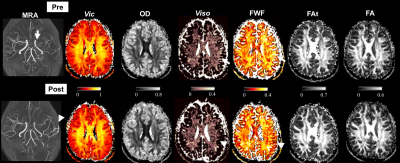 |
Longitudinal analysis revealed increased parenchymal free water may be relieved by revascularization surgery in patients with moyamoya disease
Shoko Hara1,2, Masaaki Hori2,3, Yoji Tanaka1, Taketoshi Maehara1, Shigeki Aoki2, and Tadashi Nariai1
1Neurosurgery, Tokyo Medical and Dental University, Tokyo, Japan, 2Radiology, Juntendo University, Tokyo, Japan, 3Radiology, Toho University Omori Medical Center, Tokyo, Japan
To investigate specific microstructural change after the revascularization surgery, we evaluated 13 patients with moyamoya disease and 13 age-sex matched normal controls using multishell diffusion MRI. By NODDI and free-water imaging analysis, preoperative hemispheres showed significant increase of extracellular fluid compared to controls, and subsequent significant decrease after the surgery. Only free-water eliminated parameter (orientation dispersion index) showed significant difference between patients with and without cognitive improvement after the surgery. Increased parenchymal free water observed in moyamoya disease may decrease after the surgery, and free-water elimination might be useful to detect true neuronal change related to postoperative cognitive improvement.
|
|||
4349.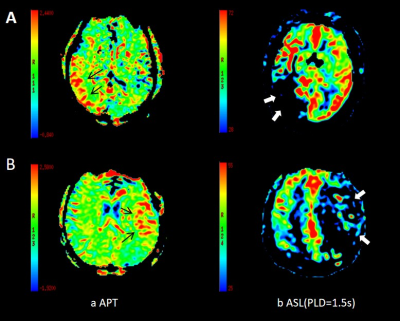 |
Feasibility of amide proton transfer weighted imaging in the diagnosis of patients with symptomatic intracranial artery stenosis
Kunjian Chen1, Weiqiang Dou2, Xinyi Wang1, Weiyin Vivian Liu2, Xinyu Wang1, Huimin Mao1, and Yu Guo1
1The First Affiliated Hospital of Shandong First Medical University, Jinan, China, 2MR Research China, GE Healthcare, Beijing, China
The main purpose was to explore the feasibility of amide proton transfer weighted (APTw) imaging in diagnosing patients with symptomatic intracranial artery stenosis (SIAS). 27 patients with severe intracranial artery stenosis (≥ 70%) or occlusion diagnosed by DSA but without infarction were recruited for MRI measurement. Compared to the contralateral area, higher APT relevant MTRasym ratio and lower cerebral-blood-flow (CBF) measured by 3D arterial-spin-labeling imaging were found in the abnormal blood supply area by the corresponding ipsilateral vessels. With these findings, APTw imaging may thus be used as an effective method providing added clinical value in diagnosing of SIAS.
|
|||
4350.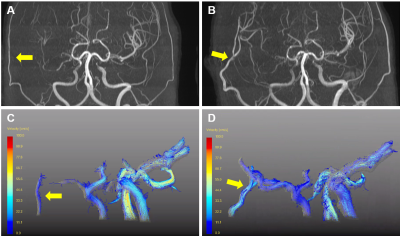 |
4D Flow MRI assessment of cerebral blood flow before and after superficial temporal artery-middle cerebral artery bypass surgery
Mingzhu Fu1, Chao Xia2, Miaoqi Zhang1, Yutao Ren2, Shuo Chen1, Rui Tian2, Yi Liu2, and Rui Li1
1Center for Biomedical Imaging Research, Department of Biomedical Engineering, Tsinghua University, Beijing, China, 2Department of Neurosurgery, West China Hospital, Sichuan University, Chengdu, China
In this study, we utilized 4D Flow MRI to assessed and compared the change of cerebral blood flow in patients with MMD before and after STA-MCA bypass surgery. Statistics indicated that BFVtotal significantly increased after bypass surgery while no differences were found in BFViICA, BFVcICA and BFVBA. This is probably because the STA-MCA bypass could directly compensate for blood flow supply and play a role in flow augmentation for the whole brain. The results of this study suggested that STA-MCA bypass could improve the cerebral blood supply without affecting the hemodynamics of other arteries, such as BA and ICA.
|
|||
4351.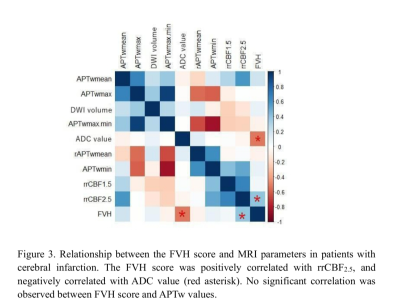 |
Relationship between FVH and the blood perfusion, acid-base metabolism and edema in patients with acute/subacute infarction
Pei-pei Chang 1, Yan Wei Miao1, Yu-han Jiang1, Yi-wei Che1, Bing-bing Gao1, Li-hua Chen1, Qing-wei Song1, Ren-wang Pu1, Ai-lian Liu1, Liang-jie Lin2, and Jia-zheng Wang2
1The First Affiliated Hospital of Dalian Medical University, Da Lian, China, 2Philips Healthcare, Bei Jing, China
This study prospectively compared the differences of fluid-attenuated inversion recovery vascular hyperintensity (FVH) score and MR measurements between patients with mild-to-moderate and severe vascular stenosis, and analyzed the relationship between the FVH score and MRI measurements. It was found that the FVH score in severe-occlusion group were higher than those in mild-to-moderate stenosis group. In addition, FVH scores were positively correlated with the ratio of relative CBF2.5 value, and negatively correlated with the ADC value, indicating FVH score was correlated with collateral circulation and brain edema. No significant correlation was observed between the FVH score and amide-proton-transfer weighted measurement, suggesting that FVH had little effect on acid-base metabolism.
|
|||
4352.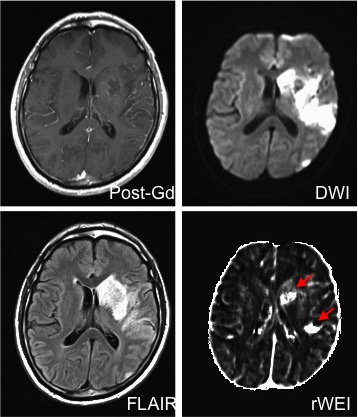 |
Mapping of Relative Water Exchange Index (rWEI) in Post Thrombectomy Patients
Young Ro Kim1 and Jerrold L Boxerman2
1Radiology, MGH, Charlestown, MA, United States, 2Neuroradiology, Brown University, Providence, RI, United States
Previously, water exchange index (WEI) was proposed to quantify the rate of water movement across the blood-brain barrier (BBB). Although efficient and clinically applicable, the technique could not reliably provide voxelwise WEI maps due to the inadequate signal to noise ratio (SNR). In remedy of this shortcoming, we here present the relative WEI (rWEI) method, which enables voxelwise mapping of BBB water exchange while significantly reducing the acquisition time (< 10 min). To confirm the validity of the technique, the rWEI maps were acquired in post thrombectomy patients with unilateral infarct and compared with the WEI values.
|
|||
4353.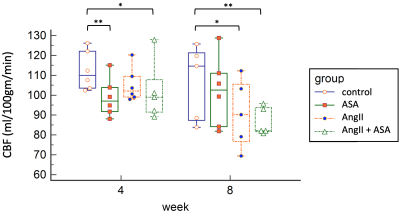 |
Effect of low dose daily aspirin on cerebral blood flow and kidney function in hypertensive rats
Greg O Cron1, Rafael Glikstein2, Jean Francois Thibodeau3, Anthony Carter3, Chet E Holterman3, Alexey Gutsol3, Lihua Zhu3, Baptiste Lacoste3, and Chris Kennedy3
1Ottawa Hospital Research Institute, Ottawa, ON, Canada, 2The Ottawa Hospital, Ottawa, ON, Canada, 3University of Ottawa, Ottawa, ON, Canada
For hypertensive patients taking low-dose aspirin, there may be risk of kidney injury. NSAIDs block vasoactive prostaglandin production, potentially blunting the reopening of hypertension-constricted renal vessels, thereby decreasing renal blood flow. We hypothesized that hypertension would predispose rats to low-dose aspirin induced kidney and cerebrovascular injury. Hypertensive rats who received low-dose daily aspirin appeared to have decreased cerebral blood flow, however the data must be interpreted with caution, as statistical power was lacking. Of interest, rats given both AngII and ASA developed significant kidney and cerebrovascular injury, suggesting a possible deleterious effect of this drug combination on the vasculature.
|
|||
4354.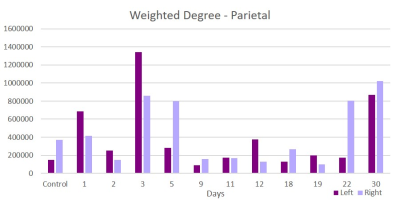 |
DTI-based Longitudinal Assessment of Stroke Recovery at 21.1 T
David C. Hike1,2, Taylor A. Ariko1,2, Frederick A. Bagdasarian1,2, Shannon Helsper1,2, and Samuel Colles Grant1,2
1National High Magnetic Field Laboratory, Florida State University, Tallahassee, FL, United States, 2Chemical & Biomedical Engineering, FAMU-FSU College of Engineering, Tallahassee, FL, United States
This research utilizes DTI and graph theory to provide a method for monitoring the progression of structural stroke recovery at 21.1 T. Edema that occurs for multiple days post the initial ischemic limits the ability for tractography to be used for any meaningful connectivity analysis before day 5. After this initial phase, graph theory provides metrics for determining the progression of recovery in major white matter regions of the ischemic brain. This method could be utilized as a means for determining the efficacies of different treatments compare with standard stroke recovery.
|
|||
4355.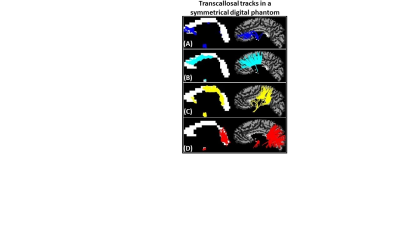 |
Fast Tractography Demonstrates the Topography of the Corpus Callosum In Ideal and Post-stroke Conditions
Jacqueline Chen1, Mark Lowe1, Ken Sakaie1, Kenneth Baker2, Andre Machado3, and Stephen Jones1
1Cleveland Clinic Imaging Institute, Cleveland, OH, United States, 2Cleveland Clinic Lerner Research Institute, Cleveland, OH, United States, 3Cleveland Clinic Neurological Institute, Cleveland, OH, United States
Accurate white-matter tractography maps can be a useful clinical tool for assessing neurological disorders, however, incorrect assumptions within tractography algorithms can yield non-physiological results. We have developed a tractography methodology based on probability theory that uses both local and global information to improve accuracy, and standard partial differential equation solvers for fast whole-brain mapping. In this abstract we demonstrate: 1) the accuracy of the method by comparing a topographical map of the corpus callosum (CC) generated from a symmetrized human data phantom to published maps; 2) how differences in CC topography may be associated with stroke location and functional disability.
|
|||
4356.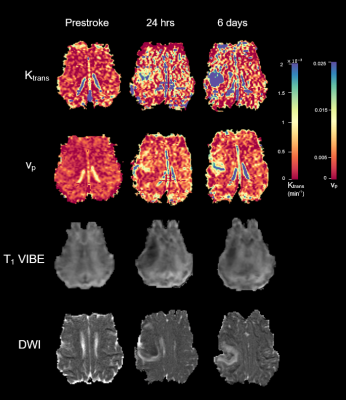 |
Quantitative Analysis of DCE-MRI Following Transient Middle Cerebral Artery Occlusion in a Novel Ovine Model
Alexandra Ereni King1, Paul D Teal2, Yu-Chieh Tzeng3, Annabel Jain Sorby-Adams4, Isabella Megan Bilecki4, Renée Jade Turner4, and Sergei Obruchkov5
1School of Chemical and Physical Sciences, Victoria University of Wellington, Wellington, New Zealand, 2School of Engineering and Computer Science, Victoria University of Wellington, Wellington, New Zealand, 3Centre for Translational Physiology, University of Otago, Wellington, New Zealand, 4Discipline of Anatomy and Pathology, University of Adelaide, Adelaide, Australia, 5Robinson Research Institute, Victoria University of Wellington, Wellington, New Zealand
Following a surgical model of transient and ischaemic stroke, 20 sheep (24-36 months; 65-75kg; 10M, 10F) underwent 2h middle cerebral artery occlusion (MCAO). Dynamic Contrast Enhanced (DCE) MRI datasets were obtained capturing the healthy animal, and progression of the infarct at 24h, 3d, 6d and 28 d post-stroke. Based on established pharmacokinetic models, analysis of these DCE-MRI images allows for calculation of perfusion parameters. The surgical procedure used is standardised and reproducible, meaning that this dataset provides an opportunity for quantitative in vivo analysis of stroke evolution in a clinically-relevant, gyrencephalic large animal model.
|
|||
4357. |
Evaluation of pharmacological hypothermia in rhesus monkey brains using diffusion MRI
Xiaodong Zhang1, Chunxia Li1, Xiaohuan Gu2, Doty Kempf1, Ling Wei2, and Shan Ping Yu2
1Yerkes Imaging Center, Emory University, Atlanta, GA, United States, 2Department of Anesthesiology, Emory University, Atlanta, GA, United States
Previous studies have demonstrated that pharmacological hypothermia could protect the brain from ischemia or traumatic brain injury in rodent models. However, it remains unknown how the brain is affected by the hypothermia in patients as the physiology and brain metabolism of human are very different from rodents. Large animal models have been recommended to improve clinical translation in the study of ischemia . In the present study, the effects of drug-induced hypothermia on the brain of adult macaque monkeys were examined using diffusion MRI. The results suggested large animals play an important role in neuroprotection research of stroke.
|
|||
4358.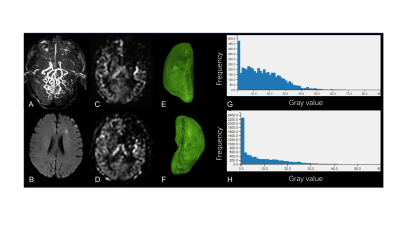 |
Predictive value of perfusion reduction on ASL for the occurrence of cerebrovascular events in patients with bilateral moyamoya angiography
Maoxue Wang1, Yongbo Yang1, Fei Zhou1, Ming Li1, Jilei Zhang2, and Bing Zhang1,3
1The Affiliated Drum Tower Hospital of Nanjing University Medical School, Nanjing, China, 2Philips Healthcare, Shanghai, China, 3Institute of Brain Science, Nanjing University Nanjing, Nanjing, China
Predictive value of perfusion reduction on ASL for the occurrence of cerebrovascular events in patients with bilateral moyamoya angiography
|
|||
4359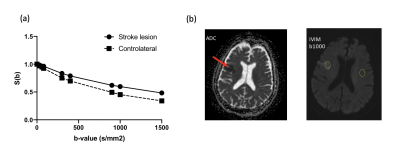 |
Intravoxel incoherent motion two-in-one MR sequence for ischemic stroke diagnosis. Initial clinical experience at 3T. Video Permission Withheld
Aude Pavilla1,2, Giulio Gambarota1, Alessandro Arrigo2, Mehdi Mejdoubi2, and Hervé Saint-Jalmes1,3
1Inserm, UMR 1099, Université de Rennes 1, LTSI, Rennes, France, 2Department of Neuroradiology, Pierre-Zobda-Quitman Hospital, University Hospital of Martinique, French West Indies, France, Fort-de-France, France, 3CRLCC, Centre Eugène Marquis, Rennes, France
This study aims to investigate the feasibility of simultaneously measuring perfusion and diffusion in the acute phase of ischemic stroke with the combined IntraVoxel Incoherent Motion and non-gaussian Diffusional Kurtosis Imaging (DKI-IVIM). For the fifteen patients enrolled, a significant decrease for the diffusion coefficient D and a significant increase in the kurtosis coefficient was observed in the infarcted lesions. Regarding the perfusion, the perfusion fraction f significantly decreased. Enhanced tissues heterogeneity was observable on reconstructed K maps. DKI-IVIM can provide with a clinically acceptable acquisition time both diffusion and perfusion characterization that might be of great interest for stroke diagnosis.
|
|||
4360.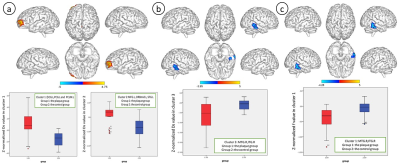 |
Altered cognition and emotion-related brain regions in asymptomatic carotid vulnerable plaque group: whole-brain voxel-wise analysis of IVIM
Shuai Yang1, Jiuqing Guo1, Lirong Ouyang1, and Weiyin Vivian Liu2
1Department of Radiology, Xiangya Hospital, Central South University, Changsha, China, 2MR Research, GE Healthcare, Beijing, China
Altered cognition and emotion-related brain regions in patients with asymptomatic carotid vulnerable plaques : preliminary whole-brain voxel-wise analysis of intravoxel incoherent motion imaging
|
|||
4361.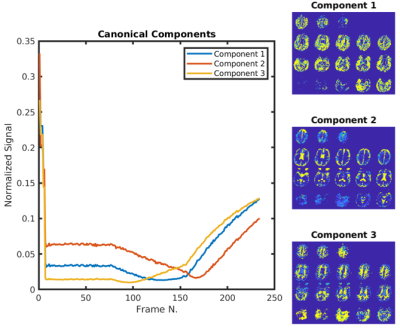 |
A Fast Tissue Segmentation Algorithm Using ASL Fingerprint Timeseries
Luis Hernandez-Garcia1, Anish Lahiri2, Scott Peltier2, Jon Fredrik Nielsen2, and Benjamin Hampstead2
1FMRI Laboratory, University of Michigan, Ann Arbor, MI, United States, 2University of Michigan, Ann Arbor, MI, United States
Partial Volume effects (PVE) in ASL have been shown to lead to significant quantification errors. PVE in ASL fingerprinting data have not been previously investigated but are also likely to introduce significant errors in quantification, given their typically coarse resolution. A simple algorithm is presented to calculate tissue fraction maps from ASL MRF timeseries data without collection of additional anatomical images. These fraction maps can be used to implement partial volume corrections as well as identify tissue abnormalities.
|
The International Society for Magnetic Resonance in Medicine is accredited by the Accreditation Council for Continuing Medical Education to provide continuing medical education for physicians.